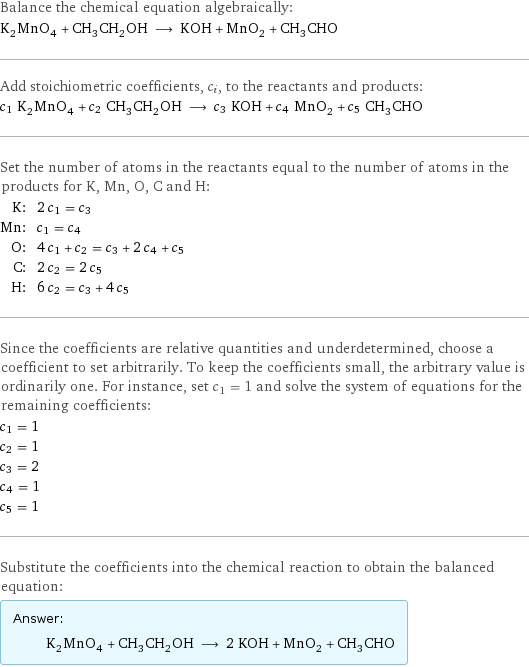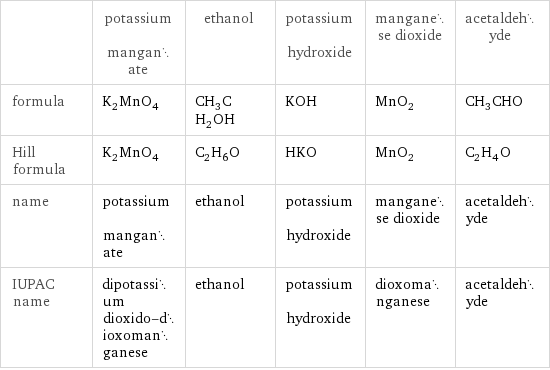Input interpretation

K_2MnO_4 (potassium manganate) + CH_3CH_2OH (ethanol) ⟶ KOH (potassium hydroxide) + MnO_2 (manganese dioxide) + CH_3CHO (acetaldehyde)
Balanced equation

Balance the chemical equation algebraically: K_2MnO_4 + CH_3CH_2OH ⟶ KOH + MnO_2 + CH_3CHO Add stoichiometric coefficients, c_i, to the reactants and products: c_1 K_2MnO_4 + c_2 CH_3CH_2OH ⟶ c_3 KOH + c_4 MnO_2 + c_5 CH_3CHO Set the number of atoms in the reactants equal to the number of atoms in the products for K, Mn, O, C and H: K: | 2 c_1 = c_3 Mn: | c_1 = c_4 O: | 4 c_1 + c_2 = c_3 + 2 c_4 + c_5 C: | 2 c_2 = 2 c_5 H: | 6 c_2 = c_3 + 4 c_5 Since the coefficients are relative quantities and underdetermined, choose a coefficient to set arbitrarily. To keep the coefficients small, the arbitrary value is ordinarily one. For instance, set c_1 = 1 and solve the system of equations for the remaining coefficients: c_1 = 1 c_2 = 1 c_3 = 2 c_4 = 1 c_5 = 1 Substitute the coefficients into the chemical reaction to obtain the balanced equation: Answer: | | K_2MnO_4 + CH_3CH_2OH ⟶ 2 KOH + MnO_2 + CH_3CHO
Structures

+ ⟶ + +
Names

potassium manganate + ethanol ⟶ potassium hydroxide + manganese dioxide + acetaldehyde
Equilibrium constant
![Construct the equilibrium constant, K, expression for: K_2MnO_4 + CH_3CH_2OH ⟶ KOH + MnO_2 + CH_3CHO Plan: • Balance the chemical equation. • Determine the stoichiometric numbers. • Assemble the activity expression for each chemical species. • Use the activity expressions to build the equilibrium constant expression. Write the balanced chemical equation: K_2MnO_4 + CH_3CH_2OH ⟶ 2 KOH + MnO_2 + CH_3CHO Assign stoichiometric numbers, ν_i, using the stoichiometric coefficients, c_i, from the balanced chemical equation in the following manner: ν_i = -c_i for reactants and ν_i = c_i for products: chemical species | c_i | ν_i K_2MnO_4 | 1 | -1 CH_3CH_2OH | 1 | -1 KOH | 2 | 2 MnO_2 | 1 | 1 CH_3CHO | 1 | 1 Assemble the activity expressions accounting for the state of matter and ν_i: chemical species | c_i | ν_i | activity expression K_2MnO_4 | 1 | -1 | ([K2MnO4])^(-1) CH_3CH_2OH | 1 | -1 | ([CH3CH2OH])^(-1) KOH | 2 | 2 | ([KOH])^2 MnO_2 | 1 | 1 | [MnO2] CH_3CHO | 1 | 1 | [CH3CHO] The equilibrium constant symbol in the concentration basis is: K_c Mulitply the activity expressions to arrive at the K_c expression: Answer: | | K_c = ([K2MnO4])^(-1) ([CH3CH2OH])^(-1) ([KOH])^2 [MnO2] [CH3CHO] = (([KOH])^2 [MnO2] [CH3CHO])/([K2MnO4] [CH3CH2OH])](../image_source/6bb4158791038b4f63cf4cd21ab3cd52.png)
Construct the equilibrium constant, K, expression for: K_2MnO_4 + CH_3CH_2OH ⟶ KOH + MnO_2 + CH_3CHO Plan: • Balance the chemical equation. • Determine the stoichiometric numbers. • Assemble the activity expression for each chemical species. • Use the activity expressions to build the equilibrium constant expression. Write the balanced chemical equation: K_2MnO_4 + CH_3CH_2OH ⟶ 2 KOH + MnO_2 + CH_3CHO Assign stoichiometric numbers, ν_i, using the stoichiometric coefficients, c_i, from the balanced chemical equation in the following manner: ν_i = -c_i for reactants and ν_i = c_i for products: chemical species | c_i | ν_i K_2MnO_4 | 1 | -1 CH_3CH_2OH | 1 | -1 KOH | 2 | 2 MnO_2 | 1 | 1 CH_3CHO | 1 | 1 Assemble the activity expressions accounting for the state of matter and ν_i: chemical species | c_i | ν_i | activity expression K_2MnO_4 | 1 | -1 | ([K2MnO4])^(-1) CH_3CH_2OH | 1 | -1 | ([CH3CH2OH])^(-1) KOH | 2 | 2 | ([KOH])^2 MnO_2 | 1 | 1 | [MnO2] CH_3CHO | 1 | 1 | [CH3CHO] The equilibrium constant symbol in the concentration basis is: K_c Mulitply the activity expressions to arrive at the K_c expression: Answer: | | K_c = ([K2MnO4])^(-1) ([CH3CH2OH])^(-1) ([KOH])^2 [MnO2] [CH3CHO] = (([KOH])^2 [MnO2] [CH3CHO])/([K2MnO4] [CH3CH2OH])
Rate of reaction
![Construct the rate of reaction expression for: K_2MnO_4 + CH_3CH_2OH ⟶ KOH + MnO_2 + CH_3CHO Plan: • Balance the chemical equation. • Determine the stoichiometric numbers. • Assemble the rate term for each chemical species. • Write the rate of reaction expression. Write the balanced chemical equation: K_2MnO_4 + CH_3CH_2OH ⟶ 2 KOH + MnO_2 + CH_3CHO Assign stoichiometric numbers, ν_i, using the stoichiometric coefficients, c_i, from the balanced chemical equation in the following manner: ν_i = -c_i for reactants and ν_i = c_i for products: chemical species | c_i | ν_i K_2MnO_4 | 1 | -1 CH_3CH_2OH | 1 | -1 KOH | 2 | 2 MnO_2 | 1 | 1 CH_3CHO | 1 | 1 The rate term for each chemical species, B_i, is 1/ν_i(Δ[B_i])/(Δt) where [B_i] is the amount concentration and t is time: chemical species | c_i | ν_i | rate term K_2MnO_4 | 1 | -1 | -(Δ[K2MnO4])/(Δt) CH_3CH_2OH | 1 | -1 | -(Δ[CH3CH2OH])/(Δt) KOH | 2 | 2 | 1/2 (Δ[KOH])/(Δt) MnO_2 | 1 | 1 | (Δ[MnO2])/(Δt) CH_3CHO | 1 | 1 | (Δ[CH3CHO])/(Δt) (for infinitesimal rate of change, replace Δ with d) Set the rate terms equal to each other to arrive at the rate expression: Answer: | | rate = -(Δ[K2MnO4])/(Δt) = -(Δ[CH3CH2OH])/(Δt) = 1/2 (Δ[KOH])/(Δt) = (Δ[MnO2])/(Δt) = (Δ[CH3CHO])/(Δt) (assuming constant volume and no accumulation of intermediates or side products)](../image_source/e6590c8250f8f0febbb7c053896b924b.png)
Construct the rate of reaction expression for: K_2MnO_4 + CH_3CH_2OH ⟶ KOH + MnO_2 + CH_3CHO Plan: • Balance the chemical equation. • Determine the stoichiometric numbers. • Assemble the rate term for each chemical species. • Write the rate of reaction expression. Write the balanced chemical equation: K_2MnO_4 + CH_3CH_2OH ⟶ 2 KOH + MnO_2 + CH_3CHO Assign stoichiometric numbers, ν_i, using the stoichiometric coefficients, c_i, from the balanced chemical equation in the following manner: ν_i = -c_i for reactants and ν_i = c_i for products: chemical species | c_i | ν_i K_2MnO_4 | 1 | -1 CH_3CH_2OH | 1 | -1 KOH | 2 | 2 MnO_2 | 1 | 1 CH_3CHO | 1 | 1 The rate term for each chemical species, B_i, is 1/ν_i(Δ[B_i])/(Δt) where [B_i] is the amount concentration and t is time: chemical species | c_i | ν_i | rate term K_2MnO_4 | 1 | -1 | -(Δ[K2MnO4])/(Δt) CH_3CH_2OH | 1 | -1 | -(Δ[CH3CH2OH])/(Δt) KOH | 2 | 2 | 1/2 (Δ[KOH])/(Δt) MnO_2 | 1 | 1 | (Δ[MnO2])/(Δt) CH_3CHO | 1 | 1 | (Δ[CH3CHO])/(Δt) (for infinitesimal rate of change, replace Δ with d) Set the rate terms equal to each other to arrive at the rate expression: Answer: | | rate = -(Δ[K2MnO4])/(Δt) = -(Δ[CH3CH2OH])/(Δt) = 1/2 (Δ[KOH])/(Δt) = (Δ[MnO2])/(Δt) = (Δ[CH3CHO])/(Δt) (assuming constant volume and no accumulation of intermediates or side products)
Chemical names and formulas

| potassium manganate | ethanol | potassium hydroxide | manganese dioxide | acetaldehyde formula | K_2MnO_4 | CH_3CH_2OH | KOH | MnO_2 | CH_3CHO Hill formula | K_2MnO_4 | C_2H_6O | HKO | MnO_2 | C_2H_4O name | potassium manganate | ethanol | potassium hydroxide | manganese dioxide | acetaldehyde IUPAC name | dipotassium dioxido-dioxomanganese | ethanol | potassium hydroxide | dioxomanganese | acetaldehyde
Substance properties

| potassium manganate | ethanol | potassium hydroxide | manganese dioxide | acetaldehyde molar mass | 197.13 g/mol | 46.07 g/mol | 56.105 g/mol | 86.936 g/mol | 44.053 g/mol phase | solid (at STP) | liquid (at STP) | solid (at STP) | solid (at STP) | gas (at STP) melting point | 190 °C | -114 °C | 406 °C | 535 °C | -123 °C boiling point | | 78 °C | 1327 °C | | 20.1 °C density | | 0.789 g/cm^3 | 2.044 g/cm^3 | 5.03 g/cm^3 | 0.784 g/cm^3 (at 20 °C) solubility in water | decomposes | miscible | soluble | insoluble | miscible surface tension | | 0.02275 N/m | | | 0.0212 N/m dynamic viscosity | | 0.001074 Pa s (at 25 °C) | 0.001 Pa s (at 550 °C) | | 2.456×10^-4 Pa s (at 15 °C)
Units
